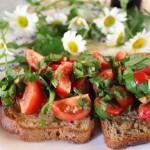Purslane Portulaca oleracea is growing rapidly now that the summer
temperatures are rising. Many New Zealanders don’t know or value it. It’s been seen as a nuisance weed that grows in our paths, flower or vegetable beds, without realizing its hidden benefits one of which is that it’s a great ground cover. And it is said to have the highest amount of Omega 3 fatty acid in the plant world, 4 mg of omega-3 fatty acids per gram, compared to .89 mg in spinach. Quite a claim to fame.
Purslane looks like a succulent, with fleshy, hairless, rounded leaves growing on reddish, branched stems. The stalkless little yellow flowers are nestled singly or in groups in the terminal cluster of new growth. The black
seeds sit in small barrel shaped capsules that split across the middle. I like taking the top off to harvest the tiny seeds sitting in their little cups. The seeds can be sprinkled on breads and biscuits.
Being an annual it likes heat and dry, spreading over the ground in summer and autumn. It is killed by cold, wet and frost. Disliking competition it grows in dry waste places, bare soil in gardens, farm gateways and yards, basically any bare ground. A friend of mine has it on the edge of her gravel driveway year after year.
Used as a food and medicine for at least 2000 years purslane is valued in many cultures and is represented in many cuisines of the world, from Greece to Mexico, and from Turkey to India by way of South Africa. I had an Iranian family come to a workshop who told me they love purslane and stir fry it with onions. I found a recipe called Kookoo khorfeh or Purslane kookoo which is an onion egg dish. I’m keen to try this.
Medicinally purslane is a soothing, healing plant that can be used for high blood pressure, anaemia, rickets, diabetes, fevers and blood disorders (its red stem is a clue that it’s good for the blood). In addition to omega-3s, it’s a good source of B vitamins – thiamine (B1), niacin (B3), pyridoxine (B6) and folate (B9), and a very good source of vitamin A (in the form of carotenes), vitamin C, riboflavin (B2), calcium, iron, magnesium, phosphorus, potassium, copper and manganese. This is an excellent edible weed for smoothies. Kings Seeds and I have purslane seeds available.
Here’s a summer salad for you to enjoy the crunchy, slightly tart, peppery flavour of purslane.
Ingredients:
1/4 cup red onion, thinly sliced
1 lemon, zested and juiced
1 tablespoon red wine vinegar
1 bunch purslane, chopped, and thick portions of stems removed
2 tablespoons olive oil
2 tablespoons plain milk yoghurt or coconut yoghurt
Pinch salt & pepper
1/2 cup feta cheese or nut cheese
1/2 cucumber, chopped
3/4 cup melon, cubed
5 radishes, thinly sliced
Method:
In a small bowl, combine the red onion, red wine vinegar, and lemon juice. Set aside to marinate for at least five minutes. Put the purslane in a large bowl and drizzle with olive oil and yoghurt. Using tongs, distribute olive oil and yoghurt evenly over the greens. Add salt, pepper, and lemon zest, and stir with tongs. Add red onions, vinegar, and lemon juice, stir with tongs, and add remaining ingredients. Inspired by Linzarella










